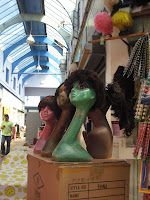On
this second journey I ended up walking from Denmark Hill in Camberwell to Clapham Common, via Brixton and Stockwell. Initially it was difficult to find a focus as I started out in a fairly mixed and quiet residential zone.
However, by the time I'd reached Brixton I had noticed a proliferation of churches and religious centres en route that suggested an ongoing theme of faith and religious devotion. This trailed off once I got into Brixton but here with the noise and visual blare of Brixton on market day I developed an interest in the strong community I witnessed, largely Afro-Caribbean, and how an area of town known for being dodgy and shabby is also home to genuinely cheerful and community-spirited people. When I reached Clapham I saw an altogether different community. The weather was glorious so people were littered across Clapham Common sunbathing and chatting. They were a community in that they were all out together. But they remain within their social pockets. As I understand it, Clapham was shabby and run-down until about the 1980's when the property-market exploded, and the 'Sloane Rangers' (sons and daughters of both the aristocracy and the upper-middle classes, who, either single or married, wanted to work in London), who traditionally bought or rented in Chelsea and South Ken, could not afford to. It became necessary for them to find new areas to colonise, and Battersea/Clapham/Balham were just across the water, and still close to the West End and the City. Thus, the gentrification of these areas.
While it's got a lovely atmosphere, I felt like the little groups or pairs of people in cafes, on the common, etc. were isolated from one another. I saw lots of people shooting disapproving looks at playing children, tutting at dogs, sitting quietly on their own reading books. There wasn't any real sense of community, nothing like that I experienced at Brixton.


























